To elevate your herbal tea, start with high-quality, fresh herbs and use the right water temperature for each type. Delicate herbs need cooler water, while robust ones can handle near-boiling temperatures. Master steeping times to avoid bitterness and extract ideal flavors. Experiment with blending complementary herbs, fruits, and spices to create unique flavor profiles. Try cold brewing for a smoother taste, or make concentrates for versatile use. Enhance your tea's aroma with floral notes and aromatherapy techniques. Balance bitter herbs with natural sweeteners or milder blends. These pro secrets will transform your tea-drinking experience into a sensory journey.
Selecting Quality Herbs

When selecting quality herbs for your herbal tea infusions, freshness is key. Opt for herbs that are vibrant in color and have a strong, pleasant aroma. Avoid herbs that appear dull, discolored, or have a musty smell, as these indicators suggest poor quality or age.
Look for whole leaves, flowers, or stems rather than pre-ground options. Whole herbs retain their essential oils and flavors better, resulting in a more robust infusion. If you're purchasing from a local market or herb shop, don't hesitate to ask about the herb's origin and harvest date.
Consider organic herbs to avoid potential pesticide residues. If you're growing your own, harvest herbs in the morning after the dew has evaporated but before the sun becomes too intense. This guarantees peak flavor and aroma retention.
Store your herbs properly to maintain their quality. Keep them in airtight containers away from direct sunlight, heat, and moisture. Dried herbs typically last 6-12 months when stored correctly.
For the best flavor, use them within the first few months after purchase or harvest.
Optimal Water Temperature
You'll find that different herbs require different water temperatures for ideal flavor extraction.
The temperature you use can greatly impact the taste of your herbal tea, with some herbs releasing their best flavors in cooler water while others need near-boiling temperatures.
It's essential to avoid oversteeping with water that's too hot, as this can lead to bitter flavors and diminish the overall quality of your herbal infusion.
Different Herbs, Different Temps
Temperature plays an essential role in extracting the perfect flavors from different herbs. You'll find that delicate herbs and flowers require cooler water, while hardier roots and bark need hotter temperatures to release their full potential.
For tender herbs like mint, chamomile, and lemon balm, use water between 160°F and 170°F (71°C to 77°C). This gentle heat preserves their subtle flavors and prevents bitterness. Green tea and white tea also fall into this category, benefiting from cooler temperatures.
Medium-bodied herbs such as rooibos, yerba mate, and oolong tea perform best with water around 180°F to 190°F (82°C to 88°C). This range allows for ideal flavor extraction without scorching.
For robust herbs like ginger, cinnamon, and black tea, use water just off the boil, around 200°F to 212°F (93°C to 100°C). These temperatures help break down tougher plant materials and release their full range of flavors and beneficial compounds.
Temperature Impact on Flavor
The ideal water temperature for brewing herbal tea can make or break your infusion. Different herbs release their flavors and beneficial compounds at varying temperatures, so it's essential to get it right. Generally, most herbal teas benefit from water that's just off the boil, around 200°F (93°C). However, some delicate herbs require cooler water to prevent bitterness or loss of subtle notes.
Here's a quick guide to suitable temperatures for common herbal teas:
| Herb Type | Temperature | Steep Time |
|---|---|---|
| Chamomile | 200°F (93°C) | 5-7 minutes |
| Peppermint | 190°F (88°C) | 3-5 minutes |
| Rooibos | 200°F (93°C) | 5-7 minutes |
Avoiding Bitter Oversteeping
While getting the right water temperature is key, it's equally important to avoid oversteeping your herbal tea. Oversteeping can result in a bitter, unpleasant taste that masks the delicate flavors you're aiming to extract. To prevent this, always follow the recommended steeping times for your specific herbal blend.
Different herbs require varying steeping times, typically ranging from 3 to 10 minutes. Keep a timer handy and remove the herbs promptly when the time's up. If you prefer a stronger brew, it's better to add more herbs rather than extending the steeping time.
Here's what happens when you overstep your herbal tea:
- Bitter compounds are released, overpowering the desired flavors
- Delicate aromatic oils evaporate, diminishing the tea's aroma
- Tannins become more concentrated, creating an astringent taste
- The tea's color may darken excessively
- Beneficial properties of the herbs can be altered or reduced
Steeping Time Mastery
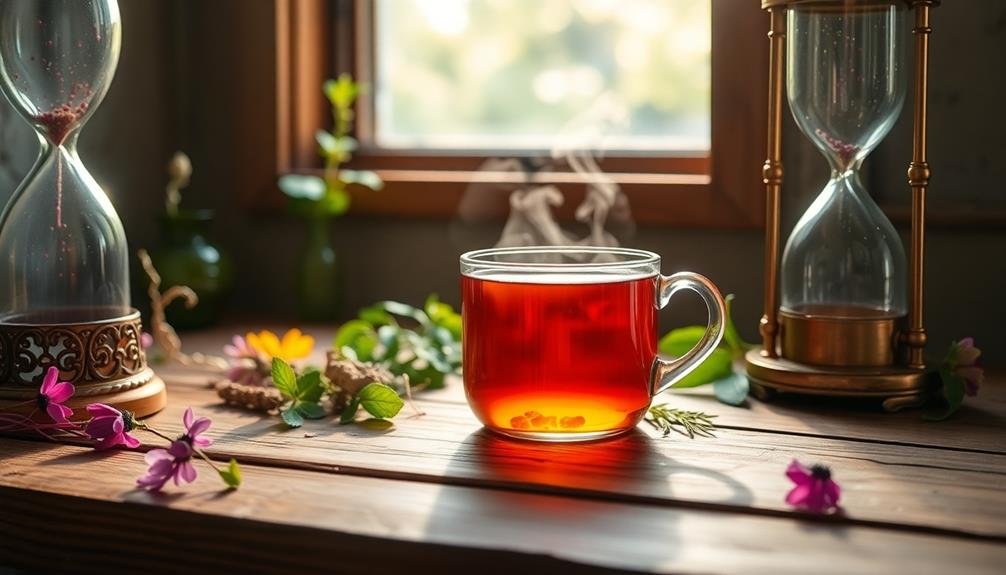
Mastering steeping time is essential for extracting the perfect flavor from your herbal tea.
You'll find that ideal steeping duration varies depending on the herb type, with some requiring as little as 3 minutes and others up to 10 minutes or more.
Optimal Steeping Duration Chart
To achieve the perfect cup of herbal tea, understanding ideal steeping times is vital. Different herbs require varying durations to release their full flavor and benefits. Here's a handy chart to guide you through best steeping times for popular herbal teas:
- Chamomile: 5-7 minutes
- Peppermint: 3-5 minutes
- Ginger: 5-10 minutes
- Hibiscus: 5-7 minutes
- Rooibos: 5-7 minutes
Remember, these times are general guidelines. You'll want to adjust based on personal preference and the specific blend you're using. Start with the lower end of the range and taste-test every 30 seconds until you reach your desired strength.
For delicate herbs like mint or lemon balm, stick to shorter steeping times to avoid bitterness. Heartier roots and barks, such as ginger or licorice, can withstand longer steep times without becoming bitter.
If you're using a blend, base your steeping time on the most delicate ingredient to prevent over-extraction.
Keep in mind that water temperature also plays a vital role in extraction. Most herbal teas do best with water just off the boil, around 200°F (93°C).
Temperature's Impact on Time
The interplay between water temperature and steeping time is essential for achieving the perfect herbal infusion. You'll find that higher temperatures generally require shorter steeping times, while cooler water needs more time to extract flavors effectively.
For delicate herbs like chamomile or mint, use water around 175°F (80°C) and steep for 3-5 minutes. This prevents bitterness and preserves the subtle nuances.
Robust herbs such as ginger or cinnamon can handle near-boiling water at 200°F (93°C), with a steeping time of 5-7 minutes to fully release their intense flavors.
Remember, as water temperature drops, you'll need to extend the steeping time. If you're using room temperature water for cold brews, plan on steeping for 6-12 hours to achieve a full-bodied infusion.
Experiment with different combinations to find your sweet spot. Start with the recommended temperature and time, then adjust based on your taste preferences.
You might discover that a slightly cooler temperature with a longer steep brings out notes you hadn't noticed before. Trust your palate and don't be afraid to fine-tune your technique for each herb.
Flavor Intensity Control
Steeping time is your secret weapon for controlling flavor intensity in herbal teas. By adjusting how long you let your herbs infuse, you'll reveal a spectrum of flavors from delicate to robust. For most herbal teas, start with a 5-minute steep and adjust from there. Lighter herbs like chamomile or mint may only need 3-4 minutes, while stronger blends with roots or barks might require up to 10 minutes.
To master steeping time, consider these factors:
- The herb's structure (leaves, flowers, roots, or stems)
- Your personal taste preferences
- The tea's intended purpose (relaxation, energy boost, or medicinal)
- The water temperature you're using
- The quality and freshness of your herbs
Blending Complementary Flavors
Harmony in your teacup begins with blending complementary flavors. To create a well-balanced herbal tea, you'll need to understand which herbs work well together. Start by identifying the dominant flavor profile you want to achieve, then select supporting herbs that enhance or contrast that profile.
Consider these classic flavor combinations:
| Base Herb | Complementary Herb 1 | Complementary Herb 2 |
|---|---|---|
| Chamomile | Lavender | Lemon Balm |
| Peppermint | Spearmint | Lemongrass |
| Rooibos | Vanilla | Cinnamon |
| Hibiscus | Rosehips | Orange Peel |
When blending, aim for a 60-30-10 ratio: 60% base herb, 30% complementary herb 1, and 10% complementary herb 2. This balance guarantees that your primary flavor shines while the supporting herbs add depth and complexity.
Don't be afraid to experiment with unexpected combinations. Floral notes can soften spicy flavors, while citrus can brighten earthy tones. Remember, your palate is unique, so trust your taste buds and adjust accordingly. With practice, you'll develop an intuition for creating harmonious blends that tantalize your senses and elevate your herbal tea experience.
Fruit Infusions for Sweetness
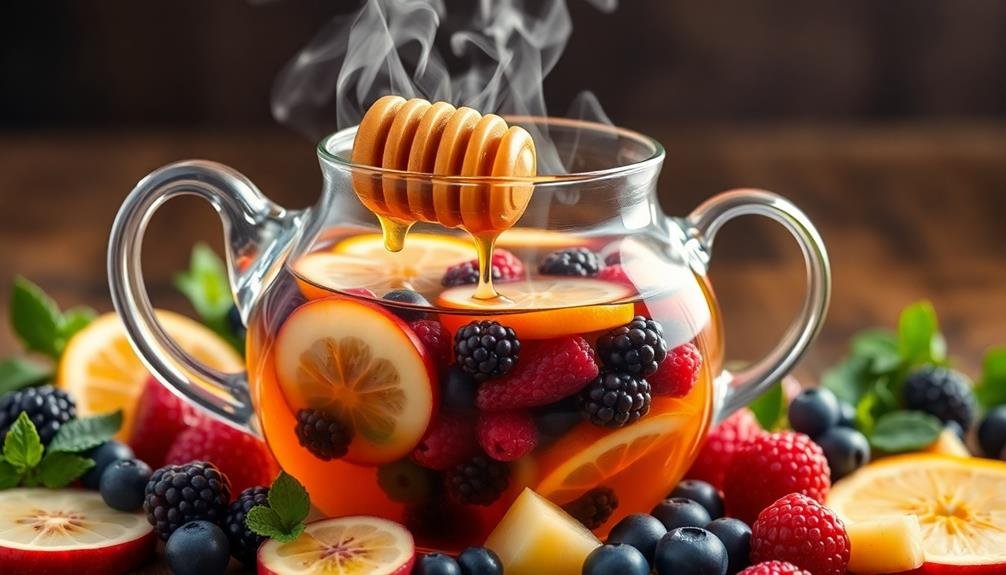
Adding fruit to your herbal tea blends can introduce natural sweetness and complexity without relying on sugar or artificial sweeteners. You'll find that dried fruits work particularly well, as they infuse their flavors more readily into hot water. Consider using apples, berries, citrus peels, or tropical fruits like mango and pineapple. These fruits not only add sweetness but also contribute unique flavor profiles and additional health benefits.
When incorporating fruit into your herbal tea, keep these tips in mind:
- Use about 1-2 teaspoons of dried fruit per cup of tea
- Combine fruits with complementary herbs for balanced flavors
- Experiment with different fruit combinations for depth
- Allow fruit-infused teas to steep longer for fuller flavor
- Consider using freeze-dried fruits for intense flavor without added sugars
Remember that some fruits pair exceptionally well with specific herbs. For instance, lemon balm and lemongrass blend beautifully with citrus fruits, while chamomile complements apple and berry flavors.
Don't be afraid to get creative and develop your own signature blends. By mastering fruit infusions, you'll elevate your herbal tea game and create delightful, naturally sweet beverages that tantalize your taste buds and support your health goals.
Spice Additions for Depth
Beyond fruit infusions, spices offer a world of depth and complexity to your herbal tea blends. Adding spices can transform a simple tea into a rich, aromatic experience. Start with classic choices like cinnamon, ginger, and cardamom. These warm spices complement many herbal bases and add a comforting note to your brew.
For a more adventurous flavor profile, try star anise, cloves, or fennel seeds. These spices bring unique tastes that can elevate your tea to new heights. Don't forget about black pepper – a small pinch can add a surprising kick and enhance other flavors.
When using spices, remember that a little goes a long way. Start with small amounts and adjust to your taste. Whole spices often provide a more nuanced flavor than ground versions. To release their full potential, lightly crush whole spices before adding them to your tea.
Experiment with spice combinations to create your signature blend. Try pairing cinnamon with star anise for a licorice-like sweetness, or combine ginger and cardamom for a chai-inspired infusion. The possibilities are endless, so don't be afraid to get creative with your spice additions.
Cold Brew Techniques
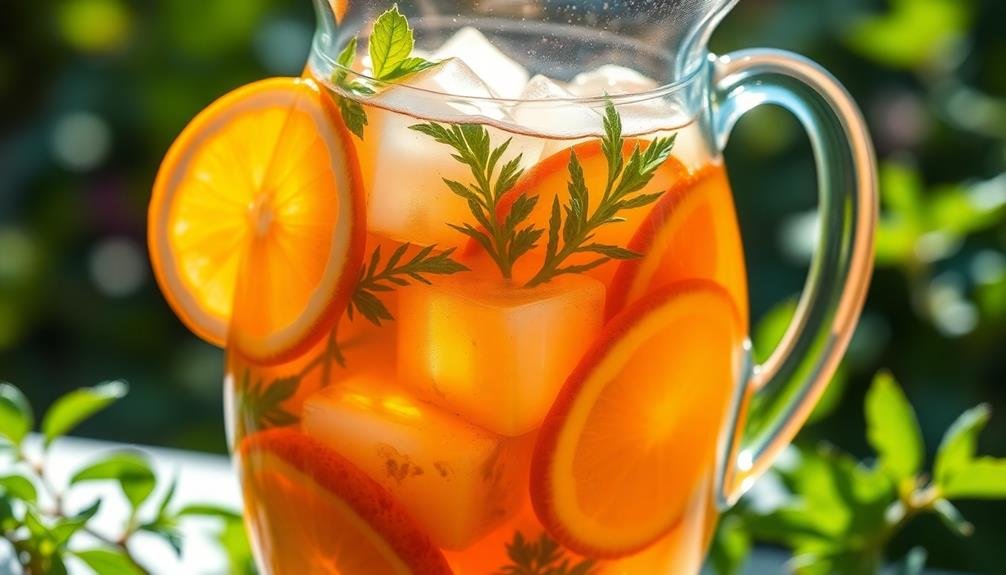
Cold brewing offers a revitalizing twist on herbal tea infusion, perfect for hot summer days or when you're craving a smoother, less bitter flavor.
To cold brew your herbal tea, simply combine your chosen herbs with room temperature or cold water in a large pitcher or jar. Use about 1.5 times the amount of herbs you'd use for hot brewing to guarantee a robust flavor. Let the mixture steep in the refrigerator for 8-12 hours, or overnight for stronger results.
After steeping, strain out the herbs and enjoy your cold brew over ice.
You'll notice a distinct difference in taste compared to hot-brewed tea:
- Mellower, less astringent flavor
- Enhanced sweetness and fruitiness
- Reduced bitterness and tannic notes
- Brighter, more vibrant color
- Longer-lasting freshness when refrigerated
For an extra flavor boost, try adding fresh fruit slices or herbs to your cold brew during the steeping process. Mint, lemon balm, or berries work particularly well.
You can also experiment with carbonated water for a sparkling herbal tea refresher. Remember, cold brewing extracts flavors differently than hot water, so don't be afraid to adjust your herb ratios and steeping time to find your perfect balance.
Layering Flavors
When you're ready to elevate your herbal tea game, layering flavors is an essential technique to master. This method involves combining multiple herbs, spices, or fruits to create complex and harmonious flavor profiles.
Start by selecting a base herb, such as chamomile or peppermint, then add complementary ingredients to enhance the overall taste.
To layer effectively, consider the strength and character of each component. Begin with milder flavors and gradually introduce stronger ones. For example, pair delicate floral notes like lavender with citrusy lemon balm, then add a hint of ginger for warmth. You can also experiment with sweet and savory combinations, such as blending rose petals with fennel seeds.
Timing is vital when layering flavors. Add hardy ingredients like roots or bark at the beginning of the brewing process, followed by leaves and flowers. Reserve delicate elements like fruit pieces for the end to preserve their freshness.
Don't be afraid to adjust ratios until you find the perfect balance. Keep a tea journal to record your successful blends and refine your recipes over time. With practice, you'll develop a keen sense for creating unique and delightful herbal tea infusions.
Herbal Tea Concentrates
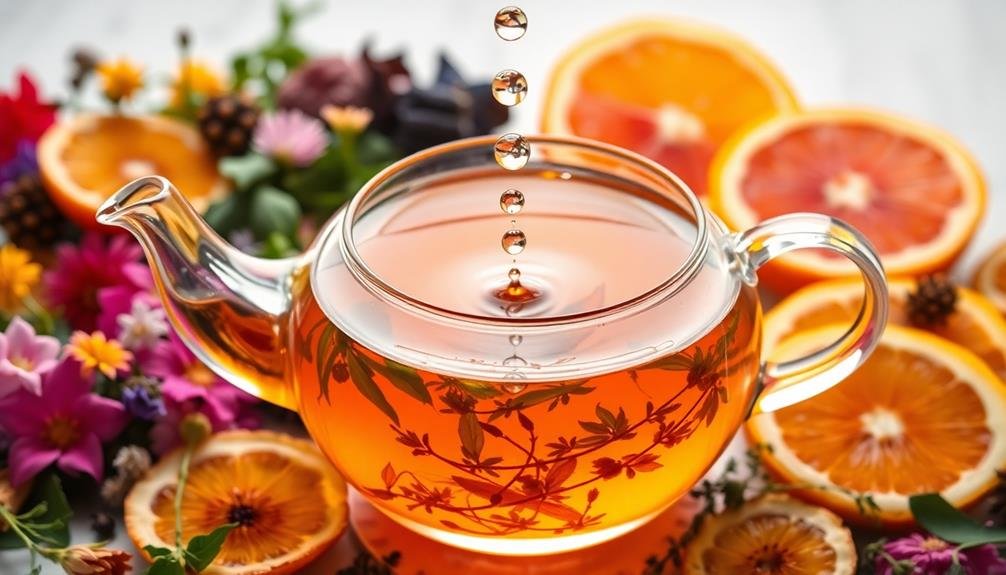
Herbal tea concentrates offer a powerful way to intensify flavors and create versatile bases for various drinks. You'll find that making these concentrated infusions can revolutionize your tea experience.
To create a concentrate, use a higher ratio of herbs to water and steep for a longer time than usual. This method extracts more flavor compounds, resulting in a potent liquid that can be diluted or used in creative ways.
When working with herbal tea concentrates, consider these possibilities:
- Mix with sparkling water for an invigorating spritzer
- Blend into smoothies for an herbal boost
- Use as a flavoring for homemade popsicles or ice cream
- Add to cocktails for unique, botanical-inspired drinks
- Freeze into ice cubes for subtly flavored water
Experiment with different herb combinations to create your signature concentrates. You might try a calming blend of chamomile and lavender or an invigorating mix of peppermint and ginger.
Remember to store your concentrates in airtight containers in the refrigerator, where they'll stay fresh for up to a week.
Floral Notes Enhancement
Nature's delicate floral aromas can transform your herbal tea into a sensory delight. To enhance these floral notes, start by selecting high-quality dried flowers like chamomile, lavender, or rose petals. Add them sparingly, as their flavors can be potent.
For a more subtle infusion, try using fresh flower petals instead.
Timing is essential when incorporating floral elements. Add delicate flowers like jasmine or orange blossom towards the end of the steeping process to preserve their volatile oils. For hardier flowers like hibiscus, you can include them from the beginning.
Don't overlook the power of complementary ingredients. Pair floral notes with citrus zest or light herbs like lemon balm to create a balanced flavor profile. Experiment with different combinations to find your perfect blend.
Temperature also plays a role in extracting floral flavors. Use water that's slightly cooler than boiling to avoid scorching delicate petals and releasing bitter notes.
For cold brews, allow the flowers to steep in cool water overnight for a revitalizing, floral-infused tea.
Balancing Bitter and Sweet
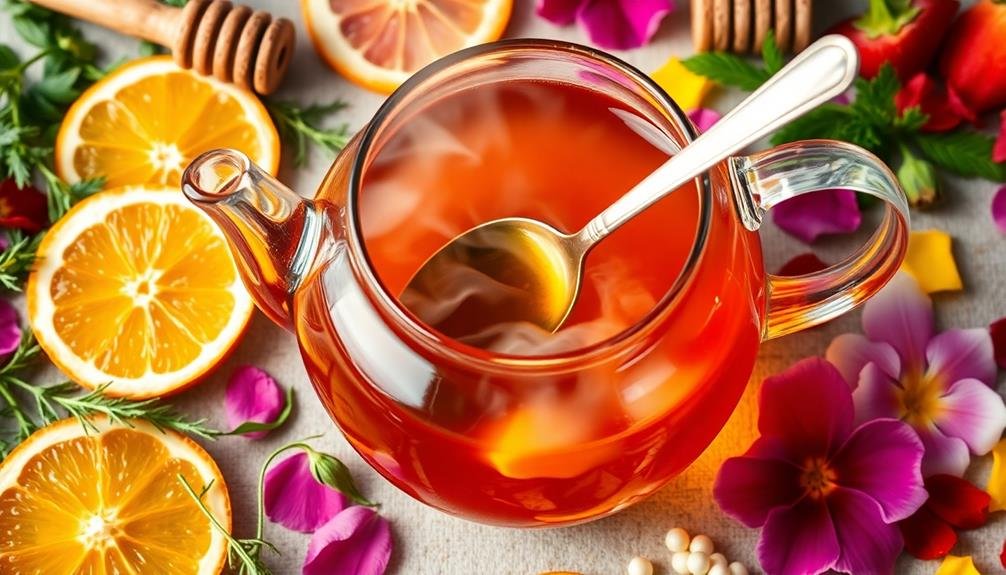
When balancing bitter and sweet flavors in herbal teas, you'll need to contemplate your sweetening options carefully.
You can opt for natural sweeteners like honey or stevia to counteract overly bitter herbs without relying on refined sugar.
To achieve harmonious blends, experiment with complementary flavor pairings that naturally offset bitterness, such as pairing chamomile with lemon balm or dandelion root with cinnamon.
Natural Sweeteners vs. Sugar
Balancing the bitter and sweet notes in herbal tea is an art form that can elevate your brewing game. When it comes to sweetening your brew, you've got choices beyond refined sugar. Natural sweeteners offer unique flavors and potential health benefits that can complement your herbal blend perfectly.
Consider these natural alternatives to sugar:
- Raw honey: Adds a floral sweetness and potential antimicrobial properties
- Stevia leaves: Provide intense sweetness without calories
- Maple syrup: Imparts a rich, caramel-like flavor
- Agave nectar: Offers a neutral sweetness that won't overpower delicate herbs
- Fruit: Fresh or dried fruits can add natural sweetness and complexity
Each sweetener interacts differently with various herbs, so experiment to find your perfect combination. Honey pairs well with chamomile, while stevia complements mint teas.
Maple syrup can enhance the earthiness of rooibos, and agave works wonders with fruity blends. Remember, a little goes a long way – start with small amounts and adjust to taste.
Counteracting Overly Bitter Herbs
Some herbal teas can pack a bitter punch that turns off even the most adventurous tea drinkers. Don't let this deter you from enjoying these healthful brews. You can easily counteract bitterness with a few simple techniques.
First, try adding a natural sweetener like honey or stevia. These not only balance the bitter notes but also enhance the overall flavor profile. If you're watching your sugar intake, a pinch of licorice root can provide sweetness without calories.
Another effective method is to blend bitter herbs with milder, aromatic ones. Pair dandelion or chicory with chamomile or lemon balm to create a more balanced infusion. Mint and citrus peels also work well to brighten bitter blends.
Adjusting your brewing technique can make a significant difference. Use cooler water and shorter steeping times for bitter herbs to reduce astringency. You can also try cold brewing, which results in a smoother, less bitter taste.
Lastly, consider adding a splash of milk or a non-dairy alternative. The fat content helps to mellow out harsh flavors and creates a more rounded mouthfeel.
Complementary Flavor Pairings
Crafting the perfect herbal tea blend often comes down to striking a balance between bitter and sweet flavors.
You'll find that complementary flavor pairings can elevate your herbal tea experience, transforming a simple brew into a complex and satisfying beverage.
When working with bitter herbs like dandelion or chicory root, consider pairing them with naturally sweet ingredients. Licorice root, for example, adds a subtle sweetness that can soften the bitter edge.
Alternatively, you might try blending in some fruit pieces or flowers to introduce a gentle sweetness and aroma.
To help you visualize some effective complementary pairings, consider these combinations:
- Chamomile and lavender for a soothing, floral blend
- Peppermint and cacao nibs for a revitalizing, chocolatey twist
- Hibiscus and rosehips for a tart, vitamin C-rich infusion
- Lemongrass and ginger for a zesty, warming cup
- Nettle and spearmint for a nutritious, minty brew
Aromatherapy in Tea Making
The art of aromatherapy extends far beyond essential oils and diffusers; it's a key element in crafting the perfect herbal tea. As you brew your next cup, consider how aromatic elements can enhance both flavor and therapeutic benefits.
Start by selecting herbs known for their fragrant properties, such as lavender, chamomile, or lemon balm. These not only taste great but also offer calming effects through their scents.
When steeping, cover your teapot or cup to trap the aromatic compounds, allowing them to infuse fully into the water.
You can also add a few drops of food-grade essential oils to your tea for an extra aromatic boost. Peppermint oil can invigorate, while bergamot can uplift your mood. Remember, a little goes a long way – start with just one or two drops.
Don't overlook the power of garnishes. Fresh mint leaves, lemon slices, or even edible flowers like rose petals can add both visual appeal and enticing aromas to your tea.
As you sip, take deep breaths to fully experience the aromatic bouquet you've created, engaging all your senses in the tea-drinking experience.
Frequently Asked Questions
Can I Reuse Herbs for Multiple Infusions?
Yes, you can reuse herbs for multiple infusions. You'll notice the flavor weakens with each steep, but you'll still get some benefits. Try experimenting with steeping times and water temperatures to maximize flavor extraction from reused herbs.
How Do I Properly Store My Herbal Tea Blends?
Store your herbal tea blends in airtight containers away from light, heat, and moisture. You'll want to keep them in a cool, dark place. Don't forget to label your containers with the blend name and date.
Are There Any Herbs I Should Avoid Mixing for Health Reasons?
You should avoid mixing herbs with potential interactions or side effects. Don't combine St. John's Wort with antidepressants, or licorice root with blood pressure medications. Always research herb interactions and consult your doctor before trying new combinations.
What's the Best Way to Strain Loose Leaf Herbal Teas?
You've got options for straining loose leaf teas. Use a tea infuser, fine-mesh strainer, or disposable tea filters. For a quick fix, try a clean cheesecloth or coffee filter. Choose what's most convenient for you.
Can I Add Milk or Non-Dairy Alternatives to Herbal Teas?
You can add milk or non-dairy alternatives to herbal teas. It's a matter of personal preference. Try different options like almond, oat, or coconut milk to find your favorite combination. Some teas pair better with certain milks than others.
In Summary
You've now discovered the secrets to elevating your herbal tea game. By carefully selecting herbs, mastering water temperature and steeping times, and experimenting with flavor combinations, you'll create truly exceptional brews. Don't forget to explore fruit infusions, concentrates, and floral notes to add depth and complexity. Remember, balance is key – play with bitter and sweet elements to find your perfect cup. Finally, engage your senses fully by embracing the aromatherapy aspects of tea-making. Happy brewing!


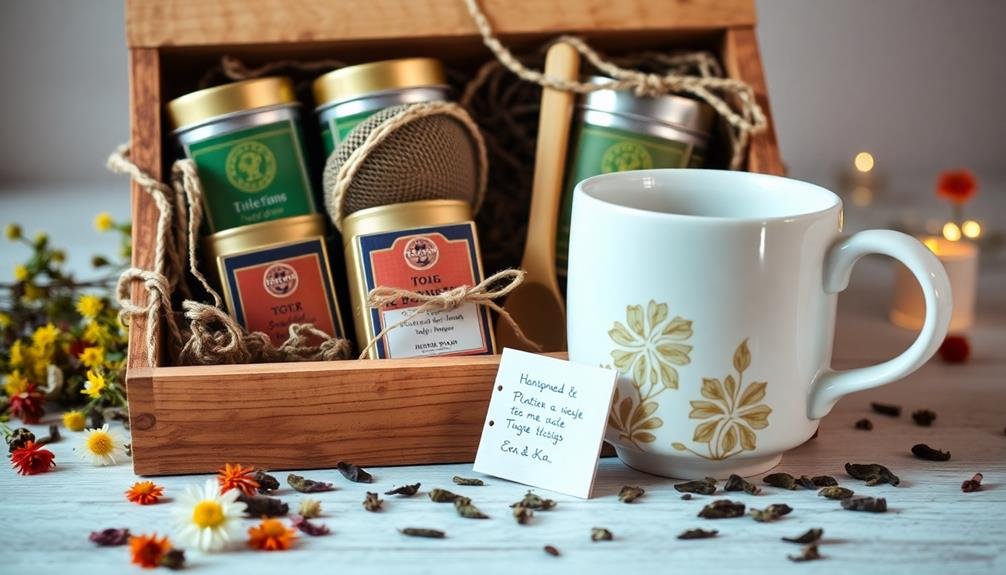
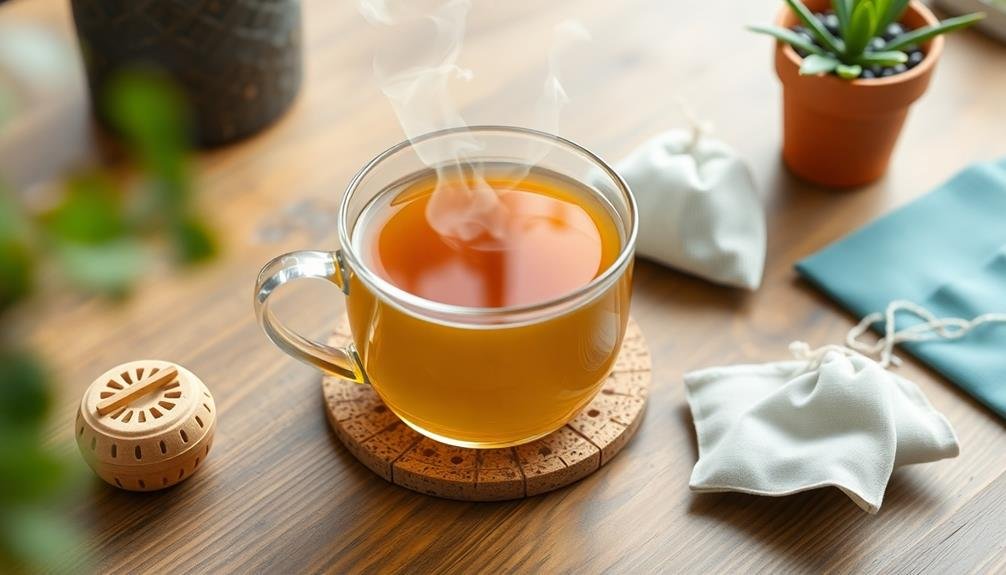
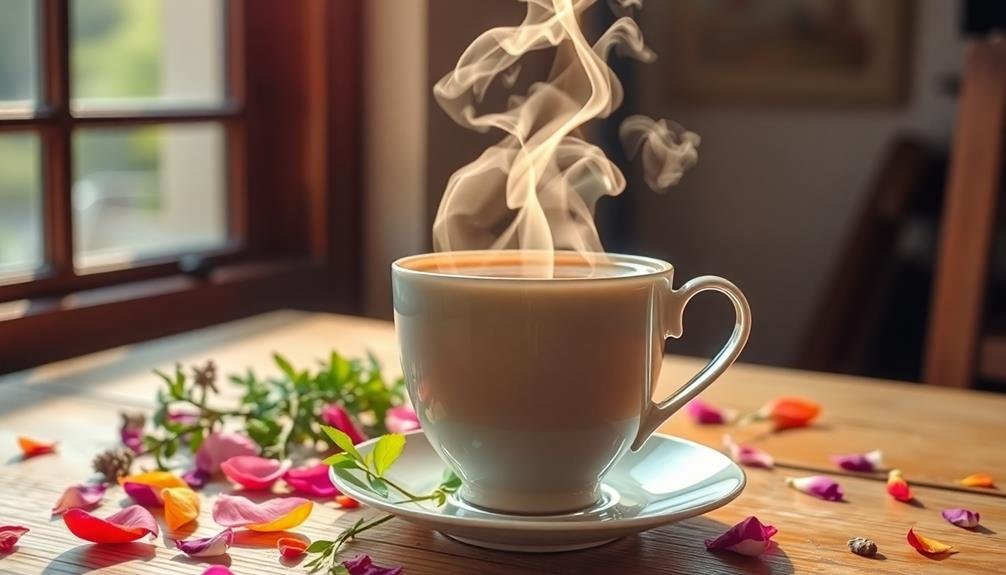
Leave a Reply